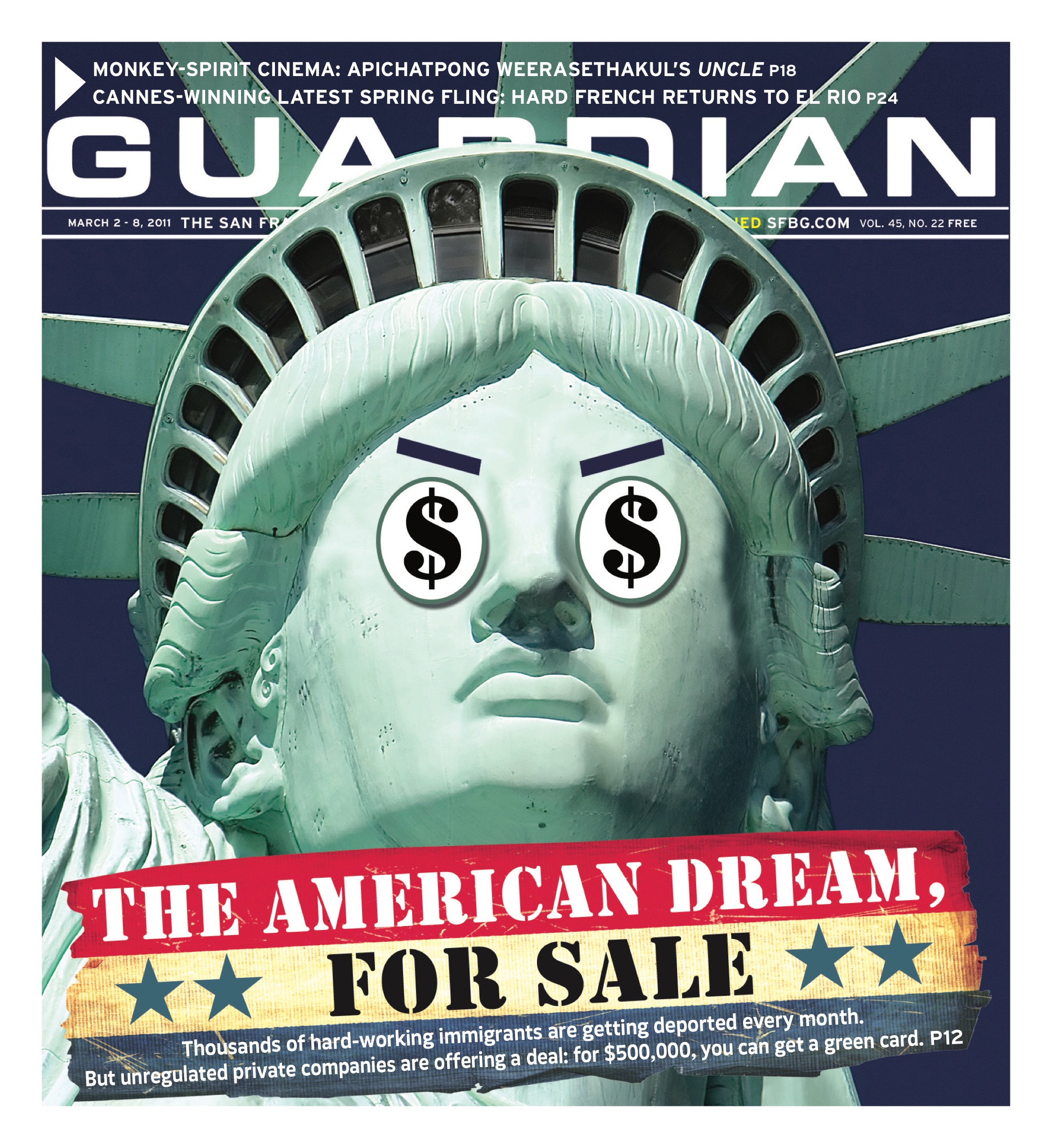› culture@sfbg.com
Perhaps it’s because I have my basic scuba license, but the idea of diving for profit has always held a certain mystique for me. It’s one thing to look at fish on vacation, but quite another to do something so dangerous and physically demanding every day.
I’ve always wondered: what kind of person chooses such a job?
The earliest commercial divers were salvage workers, roving the alien ocean floor in search of sunken treasure. At that time, when little was known about the physical effects of the frigid, high-pressure environment of the deep ocean, only men of a certain build could do it successfully.
Divers in old-fashioned canvas suits and huge round brass helmets (remember Red Rackham’s Treasure?) laid the foundations for the towers of the Golden Gate Bridge in 90 feet of chilly, turbulent water. Now pretty much anyone can take a simple course, strap on a scuba tank, and get acquainted with a coral reef. Still, it takes a particular mixture of recklessness, humor, and grim determination to do it every working day, at depths where no recreational diver is certified to go, in temperatures that would have most us running for a blanket and a cup of sugary tea.
Dean Moore, operations manager at Underwater Resources, a San Francisco firm specializing in marine construction, has one of those old-fashioned suits hanging in his office. Although the suits were massive and heavy, the brass and copper helmets were so buoyant that divers had to wear lead-weighted boots to keep from shooting to the surface. Moore has a pair of the boots as well, thought they’ve long been replaced by equipment made of Kevlar and Neoprene. Moore admits that being immersed in this world has soured him on recreational diving. When not working, he says, "I wanna stay high and dry. I think you lose a bit of the love of the sport."
Moore and his lead diver, Chris Moyer, showed me around their office and gave me a rundown of the day-to-day operation. The two are frequently called on to do some pretty nasty and unsafe work: crawling into narrow pipes, diving straight into raw sewage, or containing a pollution bloom near an oil refinery. If some politicians get their way, divers like Moyer could be getting a lot more work in the next few years building and maintaining massive offshore drilling platforms, vessels, and pipelines.
I was intrigued by all the equipment, of course — the hazmat suits and tiny robot submarines — but what really interested me is what makes these guys tick.
When asked to describe the diver’s typical personality, Moyer laughs. "Take your average motorcycle gang biker, mix in a little bit of astronaut, and a little bit of, say, a chimpanzee or a lowland gorilla, and that compilation gives you a commercial diver," he said. "I’m partial of course, but I think we’re the sexy fighter pilots of the construction world."
For Moyer, it was an ad in a scuba magazine. Like many divers, he was in the military first. When his enlistment ended, he saw the ad. "There’s this guy climbing up this ladder out of the water, and he’s wearing this neat helmet I’ve never seen before — it’s got like a light and a laser gun on it, and it says ‘Come up a winner,’<0x2009>" he explained, sitting in a small conference room with a whiteboard covered in equations and drawings. "And I’m, like, hmm, yeah."
Inspired, Moyer enrolled in the College of Oceaneering in Wilmington, where he was trained to work in cold water, low visibility, and extreme depths. He specialized as an advanced dive medic, qualifying him to recognize and treat that most notorious of divers’ ailments: the bends. Surfacing too quickly results in a sudden change of pressure, causing dissolved nitrogen in the blood to form bubbles that can lead to stroke. Moyer explains that each dive to a certain depth requires about an hour of decompression in the water, done in a series of "stops," where a diver hangs out a certain depth, allowing the nitrogen to dissolve slowly and naturally. "That buys you a few minutes when your head breaks the surface of the water before you start turning into a shaken up pop bottle," he said. Divers immediately hop in a pressurized chamber to breathe pure oxygen for a couple of hours. The sealed, all-oxygen environment carries its own hazards, and horror stories of fires and explosions abound.
After dive school, Moyer headed to the Gulf of Mexico, where 80 percent of the world’s commercial divers work, maintaining the massive oil platforms that float miles out to sea. He dove for a company whose main business was laying and repairing pipelines between platforms. Unlike Bay Area divers, workers in the Gulf aren’t unionized, so private firms regulate the industry and pay divers whatever they feel like — which, according to Moore, is sometimes a third of what a union diver can make in the Bay Area. Moore explains that though Underwater Resources can’t outbid nonunion firms for big contracts, most ambitious divers will eventually switch to unionized companies because that’s where all the interesting public-works jobs are. "Certainly in the Bay Area and up and down the West Coast, it’s expected that any decent diving company will be in the union," he said.
Maybe it was the promise of better pay that led Moyer to leave the Gulf for the Bay Area after a year. He recalls calling around looking for employment. "I’m, like, hey, I’m here and I’m ready to dive, and they’re, like, oh, that’s nice, so are all the other guys who call me every day," he remembered.
Moyer was surprised to learn that he was expected to join Pile Drivers Local 34, a division of the Northern California Carpenters Union, and start a pile-driving apprenticeship right away. With dive school and a year’s work under his belt, he didn’t like the idea of driving pile for a living. At the same time, he discovered that diving work wasn’t as consistent in the Bay Area as it had been in Louisiana, and realized it would help to have something to fall back on. As long as a member is working, Local 34 will sponsor apprenticeships, provide excellent medical benefits and, after 20 years, a handsome pension. Part of Underwater Resources’ agreement with the union is that the divers get paid for at least an eight-hour day, no matter how much time they actually spend in the water — good news in a profession where weather, complications, and injuries can cut a dive short.
Because divers are freelancers who often work offshore on drilling vessels for months at a time, the trade tends to attract outsiders, people who have difficulty conforming, and people without families. This, in addition to the close quarters that commercial divers on an offshore job have to live in —sometimes spending weeks in a small, pressurized chamber called a "dry bell" that enables them to dive to depths of 400 feet without time-consuming decompression — may partly explain why few women are in this trade. When they do work in marine construction, it’s often topside, supervising or operating the small, remotely operated ROV robots that go where it’s too deep or dangerous to send divers. Moore laments the lack of women in the industry. "We’ve never employed any. I don’t know why. It’s unfortunate — I’d be into it."
As for me? I think I’ll stick to coral reefs for now.


